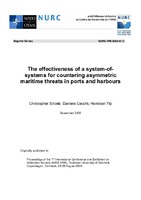| dc.contributor.author | Strode, Christopher | |
| dc.contributor.author | Cecchi, Daniele | |
| dc.contributor.author | Yip, Handson | |
| dc.date.accessioned | 2018-10-11T14:09:37Z | |
| dc.date.available | 2018-10-11T14:09:37Z | |
| dc.date.issued | 2008/09 | |
| dc.identifier | 30230 | |
| dc.identifier.govdoc | NURC-PR-2008-013 | |
| dc.identifier.uri | http://hdl.handle.net/20.500.12489/641 | |
| dc.description.abstract | A small boat loaded with explosives has been used by terrorists to attack military and civilian maritime surface vessels at berth or at anchor. For example, suicide bombers attacked the USS Cole using a small boat while in Yemen harbour (2000), and the Limburg while carrying 300,000 barrels of oil (2002). NATO is currently examining systems to protect High-Value Assets (HVA) in ports and harbours from terrorist attacks using a surface craft. | |
| dc.description.abstract | Trials have already begun to explore the operational capability of these systems in various harbour scenarios. The work explores the effectiveness of a system-of-systems to counter maritime threats to vessels and infrastructure in a port or harbour environment. Normal shipping traffic, usually high, within the harbour makes it difficult to promptly identify the intent of the threat, thus resulting in many contacts to manage and track simultaneously. Consequently, a single suicide bomber gradually closing-in on the HVA amongst the shipping traffic could mount a successful attack. Currently, we do not consider a coordinated attack by multiple threats. The response against a potential threat must be a gradual one to avoid harming innocent traffic. Furthermore, to achieve protection from asymmetric threats, any defence system must function with a high degree of efficiency and automation to minimize the | |
| dc.description.abstract | resources needed to provide continuous protection. The proposed system comprises a radar detection and tracking component coupled with an unmanned surface vehicle (USV) equipped with a non-lethal effecter. By means of simulation the study shows that existing Radar and USV technology may be used to protect a HVA from realistic contact inter-arrival rates. Furthermore, the intent of these contacts may be determined at sufficient range to allow the HVA to defend itself if necessary. | |
| dc.format | 6 p. : ill. (digital, PDF file) | |
| dc.language | English | |
| dc.publisher | NURC | |
| dc.subject | Port and harbour protection | |
| dc.subject | Force protection | |
| dc.subject | Unmanned Surface Vehicles (USV) | |
| dc.subject | Non-lethal capabilities | |
| dc.subject | Small surface craft | |
| dc.subject | Counterterrorism technology | |
| dc.title | The effectiveness of a system-of-systems for countering asymmetric maritime threats in ports and harbours | |
| dc.type | Reprint (PR) | |
| dc.type | Papers and Articles | |
